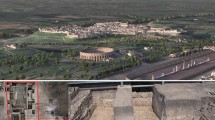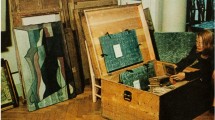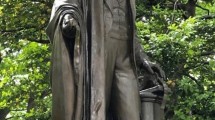Abstract
Folding fans are complex artifacts that include a variety of materials that have been processed and assembled to produce very small supports and decorations. Unfortunately, due to their fragility, as well as the lack of suitable non-invasive and non-destructive analytical techniques, the constituent materials and stratigraphies of historic folding fans have been rarely studied so far. This work aimed to develop and demonstrate a suitable analytical methodology for characterizing a French fan and to establish manufacturing techniques employed in its production. To this goal, advanced non-destructive and micro-destructive photonic techniques were employed to gather compositional and processing information with a non-invasive approach. This artifact provided the opportunity to evaluate the potential of different techniques: Portable Raman spectroscopy (with excitation at 785 nm) was used for identifying the pigments of the painted leaves and the gemstones; particle-induced X-ray emission (PIXE) and Rutherford backscattering spectrometry (RBS) were employed to quantify metal alloy compositions and stratigraphy of the decorations; portable laser-induced breakdown spectroscopy (LIBS) allowed the measurement of elemental depth profiles of metal decorations which were congruent with those provided by PIXE. Finally, additional stratigraphic information on metal decorations, in terms of gold distribution and state of conservation, was achieved through selective laser ablation.
Graphic abstract













Similar content being viewed by others
Data Availability Statement
This manuscript has associated data in a data repository. [Authors’ comment: The datasets generated during and/or analysed during the current study are available from the corresponding author on reasonable request.]
References
R.A. Crocombe, Portable spectroscopy. Appl. Spectrosc. 72, 1701–1751 (2018). https://doi.org/10.1177/0003702818809719
R. Crocombe, P. Leary, B. Kammrath, Portable Spectroscopy and Spectrometry, vol. 1 (Wiley, Hoboken, 2021)
P. Vandenabeele, H.G.M. Edwards, J. Jehlička, The role of mobile instrumentation in novel applications of Raman spectroscopy: archaeometry, geosciences, and forensics. Chem. Soc. Rev. 43, 2628–2649 (2014). https://doi.org/10.1039/c3cs60263j
P.H.O.V. Campos, C.R. Appoloni, M.A. Rizzutto et al., A low-cost portable system for elemental mapping by XRF aiming in situ analyses. Appl. Radiat. Isot. 152, 78–85 (2019). https://doi.org/10.1016/j.apradiso.2019.06.018
E. Ravaud, L. Pichon, E. Laval et al., Development of a versatile XRF scanner for the elemental imaging of paintworks. Appl. Phys. A Mater. Sci. Process. 122, 1–7 (2016). https://doi.org/10.1007/s00339-015-9522-4
I. Osticioli, D. Ciofini, M. Banchelli et al., ”Argento Deaurato” or “Argento Biancheggiato”? A rare and interesting case of silver background in Italian painting of the XIII century. Appl. Sci. (2020). https://doi.org/10.3390/app10072404
D. Saviello, L. Toniolo, S. Goidanich, F. Casadio, Non-invasive identification of plastic materials in museum collections with portable FTIR reflectance spectroscopy: reference database and practical applications. Microchem. J. 124, 868–877 (2016). https://doi.org/10.1016/j.microc.2015.07.016
D. Ciofini, J. Agresti, A.A. Mencaglia et al., Temperature sensing during Raman spectroscopy of lead white films in different purity grades and boundary conditions. Sens. Actuat. B Chem. (2020). https://doi.org/10.1016/j.snb.2020.128958
I. Nakai, Y. Abe, Portable X-ray powder diffractometer for the analysis of art and archaeological materials. Appl. Phys. A 106, 279–293 (2011). https://doi.org/10.1007/s00339-011-6694-4
M. Eveno, A. Duran, J. Castaing, A portable X-ray diffraction apparatus for in situ analyses of masters’ paintings. Appl. Phys. A 100, 577–584 (2010). https://doi.org/10.1007/s00339-010-5641-0
J. Agresti, A.A. Mencaglia, S. Siano, Development and application of a portable LIPS system for characterising copper alloy artefacts. Anal. Bioanal. Chem. 395, 2255–2262 (2009). https://doi.org/10.1007/s00216-009-3053-9
A. Giakoumaki, K. Melessanaki, D. Anglos, Laser-induced breakdown spectroscopy (LIBS) in archaeological science: applications and prospects. Anal. Bioanal. Chem. 387, 749–760 (2007). https://doi.org/10.1007/s00216-006-0908-1
S. Bright, Investigating effective support mounts for fans during display by exploring new technologies. CeROArt (2012). https://doi.org/10.4000/ceroart.2546
F. Abe, Y. Ohbuchi, T. Katayama, H. Sakamoto, Analysis of Japanese folding fan’s characteristic structure and traditional technical skill. In: WIT Transactions on Engineering Sciences. WIT Press, Ashurst (2019)
Y. Li, Useless tribute, desirable exotics: Japanese folding fans in China, 1000–1500. Sungkyun. J. East Asian Stud. 21, 27–49 (2021). https://doi.org/10.1215/15982661-8873882
D. Anglos, V. Detalle, Laser-induced breakdown spectroscopy. Laser Ind. Breakdown Spectrosc. 182, 531–554 (2014). https://doi.org/10.1007/978-3-642-45085-3
G.S. Senesi, R.S. Harmon, R.R. Hark, Field-portable and handheld laser-induced breakdown spectroscopy: historical review, current status and future prospects. Spectrochim. Acta B At. Spectrosc. 175, 106013 (2021)
M. Massi, N. Grassi, L. Giuntini, P.A. Mando, Advantages of scanning-mode ion beam analysis for the study of Cultural Heritage. Nucl. Inst. Methods Phys. Res. Sect. B Beam Interact. Mater. Atoms 256, 712–718 (2007). https://doi.org/10.1016/j.nimb.2006.12.196
L. St-Onge, M. Sabsabi, Towards quantitative depth-profile analysis using laser-induced plasma spectroscopy: investigation of galvannealed coatings on steel. Spectrochim. Acta B Spectrosc. 55, 299–308 (2000). https://doi.org/10.1016/S0584-8547(00)00146-4
A. Botto, B. Campanella, S. Legnaioli et al., Applications of laser-induced breakdown spectroscopy in cultural heritage and archaeology: a critical review. J. Anal. Atom. Spectrom. 34, 81–103 (2019). https://doi.org/10.1039/c8ja00319j
S. Siano, J. Agresti, Archaeometallurgical characterisation of Donatello’s Florentine copper alloy masterpieces using portable laser-induced plasma spectroscopy and traditional techniques. Stud. Conserv. 60, S106–S119 (2015). https://doi.org/10.1179/0039363015Z.000000000215
V. Lazic, M. Vadrucci, R. Fantoni et al., Applications of laser induced breakdown spectroscopy for cultural heritage: a comparison with XRF and PIXE techniques. Spectrochim. Acta B Atom. Spectrosc. 149, 1–14 (2018). https://doi.org/10.1016/j.sab.2018.07.012
A. Galmed, Laser induced breakdown spectroscopy and PIXE for differentiation between different tungsten alloys. J. Adv. Phys. 16, 212–220 (2019). https://doi.org/10.24297/jap.v16i1.8326
I. Osticioli, M. Bini, J. Agresti, et al., Material investigation on three special paper molds from Magnani’s museum collections. In: Proceedings of SPIE the international society for optical engineering (2013)
N. Mendes, C. Lofrumento, A. Migliori, E.M. Castellucci, Micro-Raman and particle-induced X-ray emission spectroscopy for the study of pigments and degradation products present in 17th century coloured maps. J. Raman Spectrosc. (2008). https://doi.org/10.1002/jrs
I. Osticioli, D. Ciofini, A.A. Mencaglia, S. Siano, Automated characterization of varnishes photo-degradation using portable T-controlled Raman spectroscopy. Spectrochim. Acta A Mol. Biomol. Spectrosc. 172, 182–188 (2017). https://doi.org/10.1016/j.saa.2016.03.016
F. Casadio, C. Daher, L. Bellot-Gurlet, Raman spectroscopy of cultural heritage materials: overview of applications and new frontiers in instrumentation, sampling modalities, and data processing. Top Curr. Chem. (2016). https://doi.org/10.1007/s41061-016-0061-z
D. Bersani, C. Conti, P. Matousek et al., Methodological evolutions of Raman spectroscopy in art and archaeology. Anal. Methods. (2016). https://doi.org/10.1039/c6ay02327d
M. Kono, K. Baldwin, A. Wain, A. Rode, Treating the untreatable in art and heritage materials: ultrafast laser cleaning of “cloth-of-gold.” Langmuir (2015). https://doi.org/10.1021/la504400h
M. Panzner, G. Wiedemann, M. Meier et al., Laser cleaning of gildings, in Lasers in the conservation of artworks. (Springer, Berlin, 2007), pp. 21–28
S. Siano, A. Casciani, A. Giusti et al., The Santi Quattro Coronati by Nanni di Banco: cleaning of the gilded decorations. J. Cult. Herit. 4, 123–128 (2003). https://doi.org/10.1016/S1296-2074(02)01139-1
S. Siano, F. Grazzi, Optimised pulse duration for the laser cleaning of oil gilding. Nuovo Cim della Soc Ital di Fis C 30, 123–128 (2007). https://doi.org/10.1393/ncc/i2006-10054-6
N. Taccetti, L. Giuntini, G. Casini et al., The pulsed beam facility at the 3 MV Van de Graaff accelerator in Florence: overview and examples of applications. Nucl. Instrum. Methods Phys. Res. Sect. B Beam Interact. Mater. Atoms. 188, 255–260 (2002)
M.P. Mateo, J.M. Vadillo, J.J. Laserna, Irradiance-dependent depth profiling of layered materials using laser-induced plasma spectrometry. J. Anal. Atom. Spectrom. 16, 1317–1321 (2001). https://doi.org/10.1039/b104440k
I. Osticioli, J. Agresti, C. Fornacelli et al., Potential role of LIPS elemental depth profiling in authentication studies of unglazed earthenware artifacts. J. Anal. Atom. Spectrom. 27, 827–833 (2012). https://doi.org/10.1039/c2ja30011g
C. Fourdrin, S. Pagès Camagna, C. Pacheco et al., Characterization of gold leaves on Greek terracotta figurines: a PIXE-RBS study. Microchem. J. 126, 446–453 (2016). https://doi.org/10.1016/j.microc.2015.12.030
Acknowledgements
Authors would like to thank Francesco Persico ancient fans enthusiast and refined collector. This work was supported by EU Community’s H2020-INFRAIA-Research Infrastructure programme under IPERION HS Project (GA No. 871034)
Author information
Authors and Affiliations
Corresponding authors
Rights and permissions
About this article
Cite this article
Osticioli, I., Ciofini, D., Calusi, S. et al. Advanced photonic techniques for the analysis of the composite French folding fan. Eur. Phys. J. Plus 136, 1105 (2021). https://doi.org/10.1140/epjp/s13360-021-02068-6
Received:
Accepted:
Published:
DOI: https://doi.org/10.1140/epjp/s13360-021-02068-6




